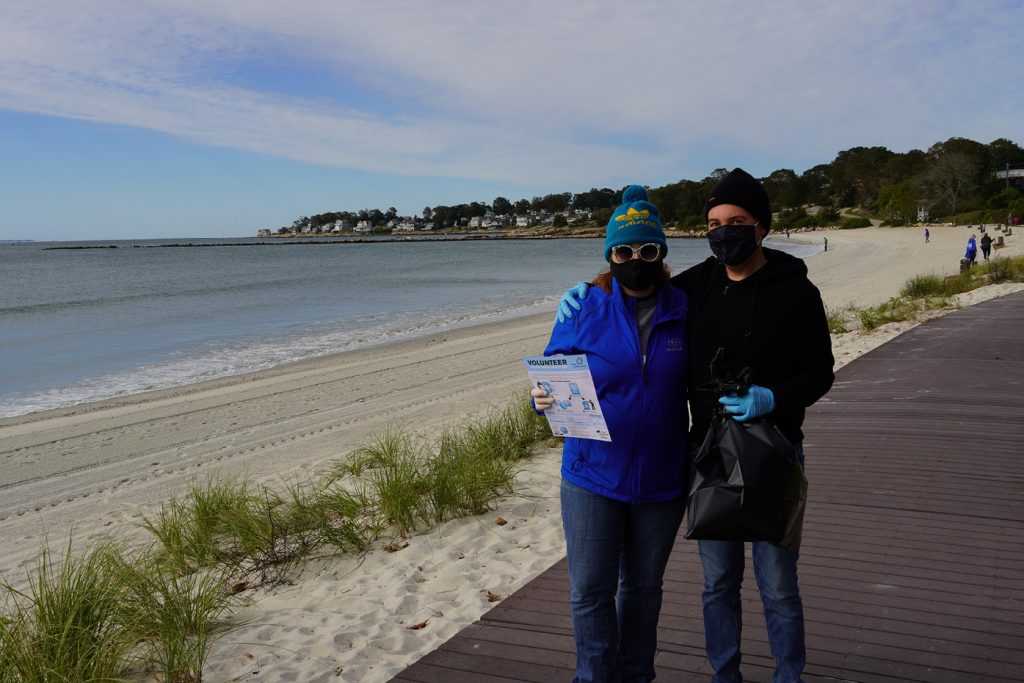
It’ll take more than a pandemic to stop Save the Sound volunteers from taking action for our region’s environment. © savethesound.org
The Connecticut River runs through the heart of the state, representing over 70% of the freshwater that reaches Long Island Sound. On its 410-mile journey from the Canadian border to the Sound, the Connecticut River ferries boaters, migratory fish, sediments, nutrients—and several tons of trash—through a diverse array of communities.
Across Connecticut, streams and rivers flow through and beneath our cities and towns. Water is everywhere—and so is trash. Cigarette butts flicked out of car windows on I-84, Styrofoam take-out containers abandoned in parks, and plastic bags blown out of trash bins all find their way into local waterways by wind, rain, and drain. There, our trash wreaks havoc on the food chain through ingestion, entanglement, and accumulation of toxins.
Reversing this tide of debris will require both the bucket (interception and removal of existing trash) and the tap (policy and behavior change). These two approaches reinforce one another in a virtuous cycle of data, policy, and action.
Last September, 1,665 volunteers across Connecticut took to their rivers and shores to stop the flow of trash. As part of this annual effort that coincides with the International Coastal Cleanup, volunteers collect data on the types of trash they find. This data, tabulated by Save the Sound and the Connecticut River Conservancy, informs and generates support for progressive trash policies at the state and local levels. These policy changes, such as the plastic bag bans passed in Connecticut and New York, help in turn to drive behavior change.
But that’s assuming that everything else is more or less constant—and the past year has been anything but. When the COVID-19 pandemic hit our region, single-use plastics staged a rapid comeback (including suspension of plastic bag bans). As with all things, 2020 trash cleanups were different than those of previous years. The structure of the event was a story of resilience, as volunteers and staff from Save the Sound and the Connecticut River Conservancy pivoted to “virtual” cleanup formats and instituted new safety protocols for in-person cleanups. The tale of the trash, however, carried a less positive message.
Across all 2020 cleanups coordinated by the two organizations, volunteers cleared more than 12,000 pounds of trash and debris. Included in that total were the steady presence of familiar items like cigarette butts (9,796), as well as a few new types of trash, such as discarded PPE (856 gloves and masks), which were a clear sign of the times. Perhaps most troubling, however, were the trends* exposed by an analysis of the year-over-year occurrence of different items. Plastic grocery bags spiked 67% from 2019 to 2020, and were joined by plastic take-out containers (+79%), formerly in steady decline. In fact, nearly every category of plastic trash increased from 2019.
While this data doesn’t prove causality, it’s easy to think that this increase in plastics and foam might be related to the change in lifestyle—towards take-out, disposable bags, and single-use items—that so many of us have adopted during the grinding evolution of the COVID-19 pandemic. Whatever the cause, one thing is certain—this trash threatens the health of wildlife, ecosystems, and each and every one of us.
There is plenty of reason for hope, however, as New York’s plastic bag ban is reinstated and Connecticut’s will go into full effect on July 1, 2021. A renewed push for a reform of Connecticut’s Bottle Bill, meanwhile, carries the possibility of a substantial increase in recycling rates. This is particularly noteworthy, since beverage containers once again dominated the list of trash last year with 12,064 removed from beaches, parks, and riverbanks. If these measures are to pass, along with others limiting or banning single-use plastics and polystyrene, they will need broad support. Should we succeed in this, the flow from the trash tap would slow, bringing us one step closer to the day when massive cleanups are no longer necessary. ■
*Trend analysis was performed on Save the Sound’s cleanup data from 2017-2020, and was adjusted for the number of cleanups held in each year.
Connecticut Cleanups Reveal Trash Trends, Fuel Policy Potential
A joint report from Save the Sound and the Connecticut River Conservancy




